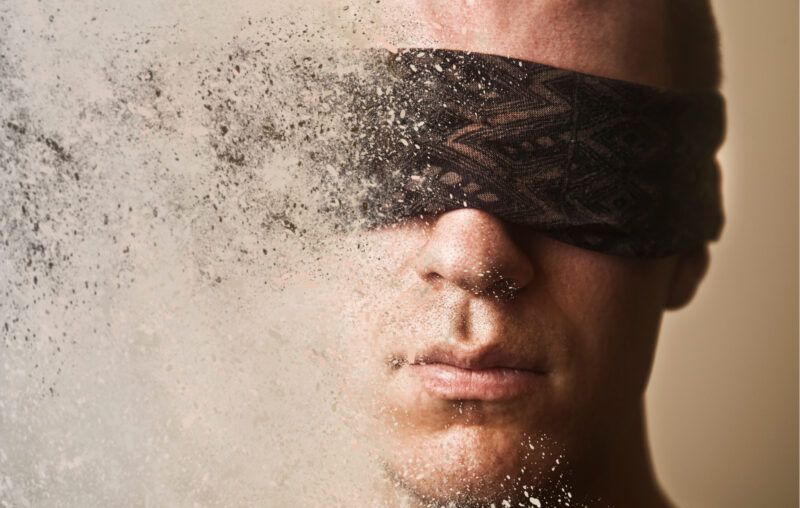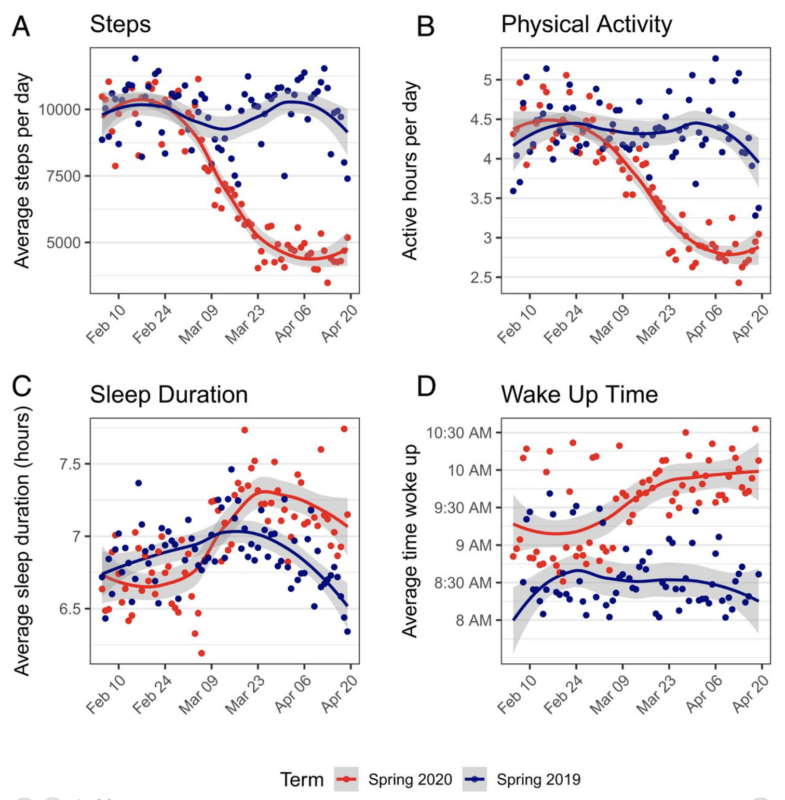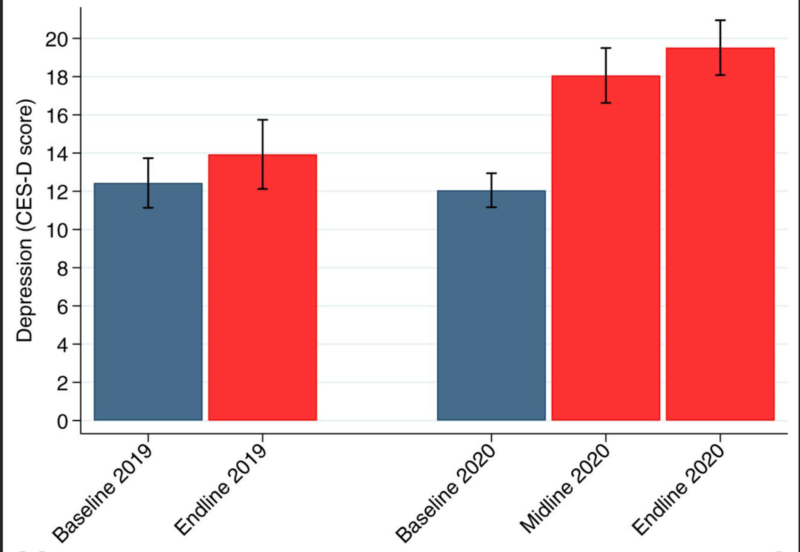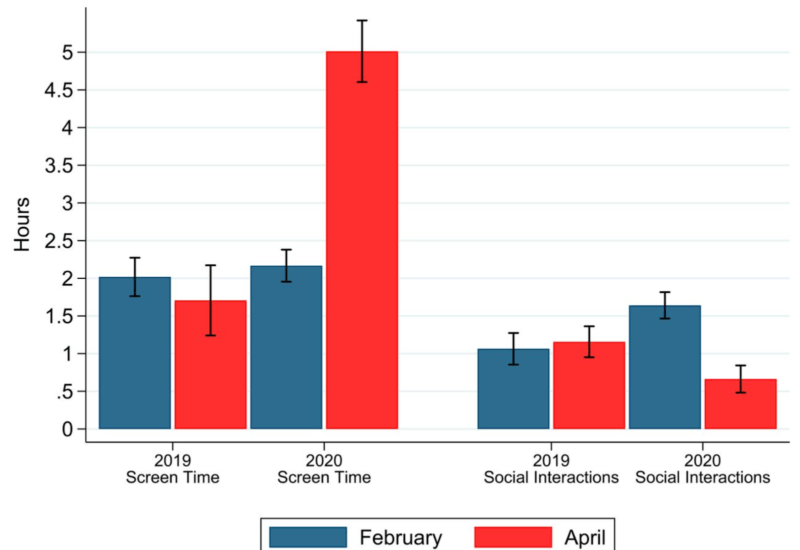The Damage of Lockdowns to Young People

In a previous article, I outlined the biological and cultural reasons why young people, mostly referring to those under the age of 30, are particularly vulnerable to the isolation as well as lifestyle disruptions brought about by lockdowns. This article will highlight some of the real damage that has been caused by such policies. Although it may be tempting to claim that such damage is necessarily due to the pandemic itself and not lockdowns, I explain how that is not the case in an article here.
An Outbreak of Suicidal Thoughts and Self-Harm
A study published by the National Academy of Sciences on students at the University of Pittsburgh found noticeable lifestyle disruptions on factors such as average steps per day, hours slept, and physical activity.

Substantial disruptions to lifestyle such as those depicted above are correlated with depression to which the study found large increases in study participants.

The study also noted that,
“We also observe a substantial drop in the number of hours spent interacting with friends, from approximately 1.5 h per day at the beginning of 2020 to less than 30 min per day at the end of April, a more than 50% decline. This drop is consistent with self-reported declines in face-to-face interactions… [w]e also document a drop in the number of work hours—driven by a subset of our participants who lost their jobs as a result of the campus closure—and a significant drop in the number of hours spent studying in the second half of the semester.”
Such disruptions to lifestyle negatively affect mental health as well as important professional and academic opportunities. The study concluded that it is clear that college students are a vulnerable population in which the pandemic is taking a heavy toll. Even more worryingly the study also found that,
“Finally, while disruption of physical habits is a leading predictor of depression during COVID-19, the restoration of habits through our short-term intervention does not help restore well-being during the pandemic.”
This conclusion is referring to a test to measure if targeted increases in physical activity such as increased step count would improve mental health, which is a common word of advice to help cope with lockdowns. The study found that although there were some improvements to mental health, overall such measures could not produce a substantial improvement to mental health.
The results for the general population have not been good. According to the American Medical Association,
“More than 40 states have reported increases in opioid-related mortality as well as ongoing concerns for those with a mental illness or substance use disorder.”
This statistic is likely exacerbated by the fact that lockdowns have not only reduced access to care for drug overdose victims but increased the market share of more potent drugs such as fentanyl which are easier to smuggle. An article in New Europe says,
“Adults under 30 experienced the highest increase in suicidal thinking in the same period, with rates of suicidal ideation rising from 12.5% to 14% in people aged 18-29. For many of the young adults surveyed, these mental health challenges persisted into the summer, despite a loosening of restrictions.”
In testimony before the US Senate on the social consequences of lockdowns, Brad Polumbo raises concern for an international epidemic of youth suicides. According to his testimony
“We are very surprised by the intensity of the desire to die among children who may be 12 or 13 years old,” a French doctor said. “We sometimes have children of 9 who already want to die. And it’s not simply a provocation or a blackmail via suicide. It is a genuine wish to end their lives.”
The number of youth suicide attempts his hospital sees in a month has more than doubled amid pandemic restrictions.
Here in the US, the Centers for Disease Control reported that 25 percent of young adults considered suicide during the lockdowns, while overall mental health issues appear to have spiked as well. CDC data show a 24 percent increase in emergency room mental health visits for children ages 5 to 11, compared to 2019. Among adolescents aged 12 to 17, that increase is 31 percent.
Micha Gartz writes for AIER when she states,
“Between March and August the National Alliance on Mental Illness HelpLine reported a 65% increase in calls and emails. The Trevor Project — which targets suicide prevention among LGBTQ youth — saw double its usual call volume. The jump in helpline calls hadn’t let up by the end of 2020: in November Crisis Text Line received 180,000 calls — its highest volume ever, and an increase of 30,000 from the previous month. Over 90% of those were from people under 35.”
AP News reports on the ongoing global youth mental health crisis by quoting a doctor at a pediatric hospital in Paris who notes,
“They don’t say, ‘Yes, I ended up here because of the coronavirus,’” Delorme said. “But what they tell you about is a chaotic world, of ‘Yes, I’m not doing my activities any more,’ ‘I’m no longer doing my music,’ ‘Going to school is hard in the mornings,’ ‘I am having difficulty waking up,’ ‘I am fed up with the mask’…
At Robert Debré, the psychiatric unit typically used to see about 20 attempted suicide cases per month involving children aged 15 and under. Not only has that number now doubled in some months since September, but some children also seem ever-more determined to end their lives, Delorme said.”
This horrifying outbreak of suicidal thoughts and actions by the younger segments of the population occur disproportionately because of their biological and social needs. Younger people from children to college students require socialization and recreational activity. Preventing them from doing so has led to dire consequences.
Spiking Anxiety
Screen time for younger individuals has always been high but lockdowns predictably led to a spike in device usage and a reduction in social interaction.

According to New Europe ,
“Virtual socialization can’t fully compensate for this deficit: social media is already a proven contributor to anxiety, depression, loneliness, and self-esteem problems among teens and preteens. Spending more time online could potentially worsen teens’ sense of isolation rather than making it better.”
The shift to digital learning and work has also led to issues relating to physical health as people get less exercise while often increasing alcohol consumption which is tied to anxiety as well as depression. One study finds that alcohol consumption spiked 262% from 2019 to March 21, 2020, and would subsequently lead to a warning being issued from the World Health Organization on the matter. Another factor tied to anxiety and depression is unwanted weight changes to which the American Psychological Association notes that 6 in 10 Americans have experienced undesired weight changes since the start of the pandemic with the most affected group being young adults aged 18-24.
An article published by The Conversation states that young people also express anxiety that has been manufactured by lockdown policies. That being concerns over whether the government is doing enough to stop the virus as well as scrutiny and stigma from peers about contracting the virus. Although such fears could be present without lockdowns, it is clear that the popular and political narratives surrounding Covid-19 have greatly exaggerated the dangers of the virus and what society is capable of doing, which in turn leads to unnecessary anxiety.
Anxiety can be worsened by factors such as existing mental health issues, concerns over the state of the world, substantial changes in lifestyle, and the removal of coping mechanisms such as spending time with friends. As specified in News Medical.net,
“People under 30 and people with a history of mental illness experience the highest levels of loneliness and anxiety during COVID-19 lockdown.”
This is especially concerning because access to mental health professionals and services were wiped out by lockdowns because schools and colleges often filled this role. It should go without saying that those from lower-income backgrounds and those that reside in areas with less infrastructure will have decreased access to such necessary services than those who do not.
Stoking fear regarding the virus and severely disrupting the normal functioning of society is not only bad for mental health but counter to traditional doctrines of public health. The late doctor Donald Henderson wrote in an essay in 2006 that,
“Experience has shown that communities faced with epidemics or other adverse events respond best and with the least anxiety when the normal social functioning of the community is least disrupted.”
Professional and Educational Setbacks
A report from the International Labor Organization warns that with the heavy economic retraction brought about by lockdowns, young people will be amongst the hardest hit due to their role in the economy. That being in entry-level jobs as well as industries like hospitality, which have been devastated by gathering restrictions. The Involvement and Participation Association notes that in the United Kingdom,
“[H]ospitality in particular being hit the worst as pubs, bars and restaurants struggle to break even. Young people, who are more likely to work in these sectors as opposed to other demographics have been greatly affected. For example, roughly 13.4% of 16-24 year olds are currently unemployed due to the virus in comparison to the national average of 4.1%.”
According to the ILO report, youth unemployment remains the highest out of any demographic and those that are employed saw a 23% reduction in working hours. For young workers, reductions in working hours and pay cuts are especially damaging, again due to their vulnerable positions as newly independent individuals. The IPA declares,
“A 20% pay cut is detrimental and faced with high rent and other living costs, during lockdown some may have had to turn towards food banks or move back to possible unstable environments with their families. This time also would have been extremely taxing for those young people with little support such as young carers and single parents.”
There have also been setbacks for white-collar professionals who may have stable jobs but have been forced to work remotely. Business professor Winny Shen observes that time in the office is essential for establishing strong networks and feeling connected to the organization. She writes,
“The spontaneous, casual workplace conversations that many workers are missing serve a deeper purpose than just socializing with friends, Prof. Shen says. Informal conversations in the office kitchen with co-workers outside your regular team can help people tap into the grapevine of company news and make people feel more connected to the broader organization.”
The ILO report also noted that 98% of survey respondents around the world reported undergoing some sort of school closure. As stated by New Europe,
“By some estimates, lockdowns have already created a loss of 0.6 years of learning time, with students in poverty and special needs students facing the steepest losses of all. Receiving less instructional time is directly correlated with lower levels of achievement.”
In guidance issued by the American Academy of Pediatrics recommending that schools remain open, they point out that,
“Schools and school-supported programs are fundamental to child and adolescent development and well-being and provide our children and adolescents with academic instruction, either in-person or virtually; social and emotional skills; safety; reliable nutrition; physical/occupational/speech therapy; mental health services; health services; and opportunities for physical activity, among other benefits. Beyond supporting the educational development of children and adolescents, schools play a critical role in addressing racial and social inequity.”
This is especially concerning as the World Bank estimates that as many as 7 million students worldwide could drop out of school due to challenging economic circumstances generated by lockdowns.
Long-Term Effects
At the time of this writing lockdowns around the world are still ongoing and it will likely take years to fully understand the long-term damage that has been done to young people by lockdowns. The increase in drug consumption, unwanted weight gain, and mental health complications will surely have lasting physical consequences. It was noted by numerous studies that targeted quarantine policies enacted to combat earlier pandemics have led to the development of symptoms that met the criteria for post-traumatic stress disorder. It is yet to be seen what the results of a population-wide lockdown will bring.
New Europe points out that using the 2008 Recession as a point of reference for the effects of highly disruptive economic events, there was a
“Rise in chronic disease risk factors, higher suicide rates, psychological distress, and lower fertility levels. We also know that childhood depression – one of the most significant consequences of COVID-19 – is tied to an increased lifetime risk of 66 diseases and premature death.”
The World Bank also estimates that the damage done by closing schools
“Is equivalent to approximately $16,000 of lost earnings over a student’s lifetime, at present value.
These learning losses could translate over time into $10 trillion of lost earnings for the global economy because of lower levels of learning, the lost months of schooling during the lockdown.”
There are also unquantifiable losses that will have long-term consequences such as the diminishment of social capital and friendships, memorable life events such as proms, sports games, concerts, and other large events. Such losses will most likely result in lasting professional, emotional, and social consequences.
Key Takeaways
It goes without saying that societal institutions exist for a reason and abruptly pulling them out from underneath everyone’s feet may have dire consequences. That is what policy makers have done with lockdowns. They have attempted to tamper with the natural order of society and unleashed misery.
Young people in particular are vulnerable to lockdowns because of their biological and developmental necessities that are linked to in-person socialization. In-person schooling, patronizing bars and restaurants, going to parties, attending concerts, seeing friends, reporting to the office; all these activities play an important role in the psychological as well as developmental needs of young people. Banning these activities has not been a minor inconvenience. They have opened a Pandora’s Box of short and long-term consequences that encompass physical, mental, and financial hardship that have devastated the lives of young people across the world. Lockdowns have not only failed to stop Covid-19, they have created not one but multiple public health crises.










